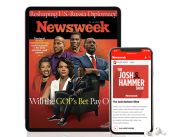The Fear Factor of Unfamiliarity: Uniting Faith and Media Sectors
A knowledge gap, among other factors, impacts the relationship between faith and media.

There's an age-old communications challenge that has been at the heart of my work for years: how do you create more understanding and fluency between two vital sectors that have often avoided one another? How do you overcome the fear factor of unfamiliarity between two industries that are sometimes wary of one another, yet which are both critical to our civil society?
Late last year, I was honored to be a part of the official launch of the Faith and Media Initiative — an organization founded on the importance of asking these questions within the faith and media sectors — along with the findings of their first-of-its-kind global research study.
The Global Faith and Media Study surveyed nearly 10,000 people from 18 different countries, and revealed that the lack of understanding between these two crucial sectors is not the result of deliberate avoidance, nor is it the fault of hardworking journalists or dedicated faith leaders; rather, it's a byproduct of a fear factor that exists within both industries.
Media interviewees described general anxiety around covering communities and matters of faith, expressing fear of "getting faith coverage wrong" or unintentionally offending others in an era where religion has become increasingly politicized and contentious. Faith leaders have cited hesitancy to speak on the record for fear of being drawn into conversations about controversial matters.
In order to overcome this gap, members of the media have expressed an eagerness to better understand and engage with faith institutions in a meaningful way. But where to start? Here are three things I hear as part of this conversation, and that we should keep top of mind:
1. Media wants open communication.
According to a global study on the depictions of faith in the media, 63% of faith-related content in the media is often provocative or depicts religious institutions in a negative light — which itself is reflective of the concerns named above, but which makes it unsurprising that the Global Faith and Media Study found faith leaders are hesitant to speak about news topics that could be interpreted as politicized or controversial. Faith leaders tend to engage with the media on a reactive basis and offer sanitized sound bytes instead of speaking with candor — or worse, avoiding the media altogether.
Trust is the foundation of any strong relationship and is something that can only be cultivated with sustained effort — and proactive communication with the media can be a great first step.
Journalists are busier than ever — with an estimated 51% publishing five or more stories a week — but still need some effort put in from outside the media world to build better relationships with their sources. By putting this effort into practice, the foundation can be laid for faith leaders to build sustained relationships with press that will pay long-term dividends. The religious news media is hungry for this kind of engagement, as journalists who cover religion report they are more likely to respond to story pitches compared to their counterparts on other beats.
2. Media wants to hear from more — and more diverse — members of faith communities.
While it is difficult to find more recent studies, a 2012 look at religion found 84% of the world's population was affiliated with a religion —which adds up to billions of people around the globe. There is a lot to learn — and a lot to celebrate — about how our friends and neighbors are living and expressing their faith.
Members of the media noted in this study that they would like to hear from more folks beyond traditional spokespeople to better understand the lived experiences of people of faith. This presents a perfect opportunity for faith leaders to empower those in their communities to publicly share more about their lived spiritual experiences, as well as speak to the good work faith institutions are doing to better their communities.
It's estimated that faith-based organizations account for 40% of social safety net spending in the U.S., and that the majority of religious congregations in America have programs to help the underserved — providing food, shelter, clothing and more to those in need. It's time for faith leaders to spread the good word about these efforts — as the public experiences more than enough of the controversial news of the world.
3. Media want to increase their "faith fluency."
Less than 20% of journalists surveyed say they understand the nuances of faith beyond the religious traditions with which they grew up and often cite the lack of time and resources to report on matters of faith with the nuance and sensitivity it deserves. This phenomenon, which can be described as a gap in "faith fluency," means that catering to short attention spans within a hyper-paced news cycle makes it more efficient to use assumptions before providing context.
There's an opportunity for faith institutions to step in to help bridge this knowledge gap. In addition to prioritizing open communication with journalists and empowering more people of faith to share their stories, faith leaders can engage with organizations that dedicate themselves to education for both sectors and eventually bring the gap a bit closer together.
There are serious institutions doing important work to make trainings available to journalists worldwide. Their work should be treated as a mandate, not just an afterthought.
Improving the understanding between these two areas won't happen overnight. And bringing them together is much more than just looking past the hard questions. But if bringing these two sectors closer together sounds urgent, there is a reason: never has there been a time when what makes us human — including our search for what is divine within us — is more needed.

